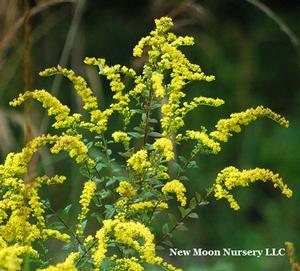Printed at http://www.newmoonnursery.com/index.cfm/
Solidago rugosa
Wrinkle-leaf goldenrod
Native to North America
FIRST IMPRESSIONS: Solidago rugosa is an upright perennial wildflower with sturdy pubescent stems. Leaves are lance shaped or ovate. The blade surface is rugose with deeply indented veins that impart a wrinkled appearance. From late summer until autumn, plants are topped by attractive golden-yellow flower panicles. This lovely goldenrod prospers in sunny or lightly shaded moist well-drained sites.
HABITAT & HARDINESS: Solidago rugosa occurs from Newfoundland and Labrador to the Florida panhandle and west from Ontario to Wisconsin and Texas.
Indigenous plants occur in wet sandy prairies, swamps and marshes, gravelly seeps, low open woods, pine barrens, swampy meadows and thickets, bogs, moist sand dunes, rocky cliffs or bluffs and abandoned fields. This goldenrod is found most often in moist sandy sites or near sandstone outcrops.
Plants are hardy from USDA Zones 4-9.
PLANT DESCRIPTION: Solidago rugosa is an erect clumping perennial with pubescent green or reddish stems.
Leaves are alternate and about 4” long and 1½” across. The blades have a wrinkled surface, toothed margin and short broad petiole. They are broadest toward the base with an ovate to lanceolate shape.
From late summer until fall for 1-2 months, stems are terminated by showy golden flower panicles. The inflorescences can vary in shape from narrow and raceme-like to wide and spreading with arching branches.
The individual flowerheads are about 1/8” wide with 4-8 ray florets surrounding a similar number of disc florets.
The florets mature into small bullet shaped achenes crowned by tufts of hair.
Plants grow 3-6’ tall with a 1.5-3’ spread. Plants spread at a moderate rate to form colonies from underground rhizomes.
CULTURAL & MAINTENANCE NEEDS: Solidago rugosa thrives in sunny well drained, slightly acid, average, mesic or wet soils. Plants tolerate light shade, slightly alkaline pH, sandy, gravelly loamy or clay soils and some drought.
Plants proliferate from rhizomes and self-seeding but are generally not considered to be invasive. If seedlings are a problem, deadhead to remove spent flower before the seed ripen.
This species is relatively pest free except for an occasional bout with rust or powdery mildew.
LANDSCAPE USES: This is a good choice for use as a Butterfly Nectar Plant, Grouping or Mass Planting in a Wildlife Garden or Meadow. Solidago rugosa has Showy Blooms and is appropriate for Cottage Gardens, Low Maintenance Plantings, Perennial Borders, Rain Gardens and Restoration Projects.
COMPANION & UNDERSTUDY PLANTS: Try pairing Solidago rugosa with Aster novae-angliae, Chyrsopsis mariana, Coreopsis tripteris, Eupatorium hyssopifolium Liatris spicata, Panicum virgatum or Rudbeckia triloba.
Solidago speciosa is another tall goldenrod with similar season of bloom that could be a good companion or substitute in some naturalized areas. In garden situations, Solidago rugosa ‘Fireworks’ could stand in for the species.
TRIVIA: Solidago rugosa provides a valuable late season source of nectar and pollen for native bees, wasps, butterflies, moths, beetles and pollinating flies. Plants host caterpillars of several moth species. Seed are eaten by the Eastern Goldfinch, Indigo Bunting and Swamp Sparrow. Young foliage is occasionally nibbled by White-tailed Deer and other herbivores.
Solidago rugosa can be distinguished from other Solidago spp. by the very hairy stems and the rugose or wrinkled appearance of the leaf blades.
Solidago rugosa is sometimes called Rough-leaf Goldenrod, Rough-stemmed Goldenrod or Rough Goldenrod.
Height:
3-6 FeetSpread:
2-3 ftSpacing:
3-6 ftUSDA Hardiness Zone:
4-9Bloom Color:
YellowSolidago rugosa Characteristics
Attracts Wildlife
- Songbirds
- Pollinators
- Butterflies
Attributes
- Drought Tolerant
- Dried Flower
- Cut Flower
- Naturalizing
- Long Blooming
Exposure
- Full Sun
Flowering Months
- October
- September
Foliage Color
- Green
Juglans nigra Tolerance (Black Walnut)
- Yes
Soil Moisture Preference
- Moist to Wet

